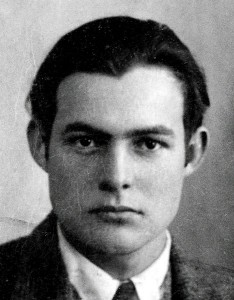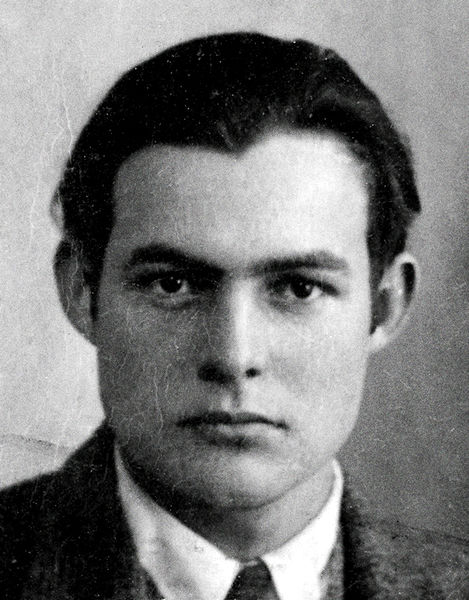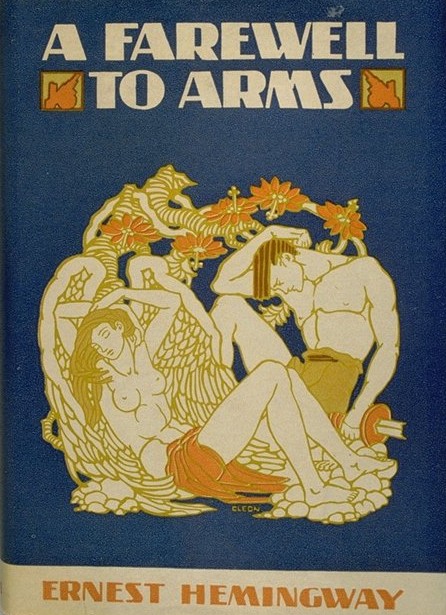 ERNEST MILLER “PAPA” HEMINGWAY
ERNEST MILLER “PAPA” HEMINGWAY
Born: July 21,1899, Oak Park, Illinois
Died: July 2, 1961, Ketchum, Idaho — Suicide
Ernest “Papa” Hemingway is the expatriate writer we love to hate and hate to love. He is the superhero/antihero equivalent of literary greatness with a Royal Quiet de Luxeon at his hip and a bottle of “grog” in his hand, shirt ripped open for the world to see his big, manly, hairy chest. Journalist, world traveler, fighter, marrying man, decorated WWI Italian army volunteer, sportsman, fisherman, big game hunter, Hemingway’s bravado made him infamous and a fine dinner guest. His contributions to the community of letters is unattested, bringing an understatement and simplicity of style to the modernist canon like none before him. John Updike and Joan Didion, and many more, claim him as a major inspiration. As likely to carry a urinal home from Sloppy Joe’s, his Key West bar hangout, as he was to write major literary works, Hemingway, the man, was sometimes larger than his work and made him the media eye candy of his time.
When I am working on a book or a story I write every morning as soon after first light as possible. There is no one to disturb you and it is cool or cold and you come to your work and warm as you write. You read what you have written and, as you always stop when you know what is going to happen next, you go on from there. You write until you come to a place where you still have your juice and know what will happen next and you stop and try to live through until the next day when you hit it again. You have started at six in the morning, say, and may go on until noon or be through before that. When you stop you are as empty, and at the same time never empty but filling, as when you have made love to someone you love. Nothing can hurt you, nothing can happen, nothing means anything until the next day when you do it again. It is the wait until the next day that is hard to get through.
— Ernest Hemingway, The Art of Fiction No. 21, The Paris Review
A Conversation with George Plimpton in a Madrid Café, 1954
Hemingway is arguably the patriarch of the Paris expatriates with Gertrude Stein his matriarch and F. Scott Fitzgerald his chum. Rest in Peace, Papa.
HEMINGWAY’S FIGHTS
Hemingway vs. Wallace Stevens (1936) Street fight, Key West, Florida
Hemingway vs. Max Eastman (1938) Max Perkins’ Office, Scribner’s, New York, New York
HEMINGWAY’S FAVORITE BARS
Sloppy Joe’s — Key West, Florida
Floridita Bar, San Francisco, Cuba
Dôme, Paris, France
HEMINGWAY’S WIVES
Elizabeth Hadley Richardson (1891 — 1979)
- Married 1921
- Divorced 1926
Pauline Marie Pfeiffer (1895 — 1951)
- Married 1927
- Divorced 1940
Martha Ellis Gellhorn (1908 — 1998)
- Married 1940
- Divorced 1945
Mary Welsh Hemingway (1908 — 1986)
- Married 1946
- Widow
HEMINGWAY’S NOTABLE WORKS
“Indian Camp” (1924, Transatlantic Review)
In Our Time (1925, collection)
The Sun Also Rises (1926)
Death in the Afternoon (???)
“Hills Like White Elephants” (1927)
Men Without Women (1927)
A Farewell to Arms (1929)
“The Short Happy Life of Francis Macomber” (1935)
“The Snows of Kilimanjaro” (1936, Esquire)
The Fifth Column and the First Forty-Nine Stories (1938)
For Whom the Bell Tolls (1940)
Across the River and into the Trees (1950)
The Old Man and the Sea (1952)
A Moveable Feast (1964)
Islands in the Stream (1970)
True at First Light (1999)
More Books…
HEMINGWAY’S AWARDS
The Pulitzer Prize in Fiction (Finalist, 1941) For Whom the Bell Tolls
The Pulitzer Prize in Fiction (1953) The Old Man and the Sea
The Nobel Prize in Literature (1954)
SOURCES
Heller, Nathan. “Hemingway: How the Great Novelist Became the Literary Equivalent of the Nike Swoosh.” Slate Magazine. March 16, 2012.
Lost Generation. “Ernest Hemingway Biography.” n.d.
Nobel Lectures. Literature 1901-1967, Editor Horst Frenz, Elsevier Publishing Company, Amsterdam, 1969.
Plimpton, George. “Ernest Hemingway: The Art of Fiction No. 21.” The Paris Review. May 1954. n.d.
Rich, Frank K. “Hemingway.” Modern Drunkard Magazine. n.d.
ADDITIONAL RESOURCES
www.pen-ne.org/news-noteworthy/penhemingway-award



